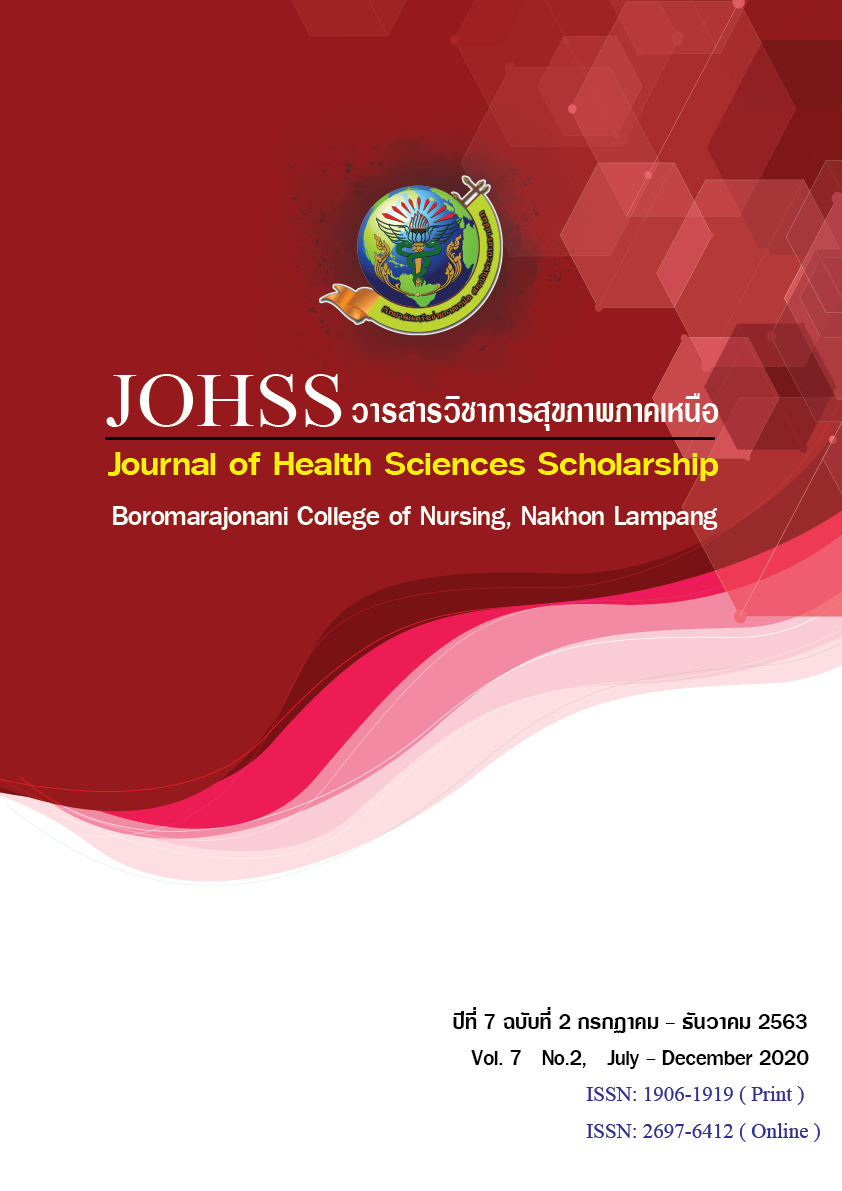พฤติกรรมการดูแลตนเองของผู้ป่วยโรคนิ่วในระบบทางเดินปัสสาวะที่มารับบริการที่โรงพยาบาลสมุทรสาคร
คำสำคัญ:
โรคนิ่วระบบทางเดินปัสสาวะ, พฤติกรรมการดูแลตนเองบทคัดย่อ
นิ่วในระบบทางเดินปัสสาวะเป็นปัญหาสาธารณสุขของประชาชนในประเทศไทย การวิจัยเชิงพรรณนาแบบตัดขวางครั้งนี้มีวัตถุประสงค์เพื่อ 1) ศึกษาระดับพฤติกรรมการดูแลตนเองของผู้ป่วยโรคนิ่วในระบบทางเดินปัสสาวะ และ 2) ศึกษาปัจจัยที่มีผลต่อพฤติกรรมการดูแลตนเองของผู้ป่วยโรคนิ่วในระบบทางเดินปัสสาวะ โดยการสัมภาษณ์โดยใช้แบบสอบถามกับผู้ป่วยโรคนิ่วในระบบทางเดินปัสสาวะที่มารับการรักษาที่โรงพยาบาลสมุทรสาคร จำนวน 250 ราย วิเคราะห์ข้อมูลทั่วไปด้วยสถิติเชิงบรรยายและวิเคราะห์หาปัจจัยส่วนบุคคลกับพฤติกรรมการดูแลตนเองโดยการวิเคราะห์ถดถอยเชิงพหุคูณ
ผลการศึกษาพบว่า กลุ่มตัวอย่างส่วนใหญ่มี พฤติกรรมการดูแลตนเองของผู้ป่วยโรคนิ่วในระบบทางเดินปัสสาวะ ระดับปานกลาง ( = 3.15,SD = 0.722) และพบว่าปัจจัยที่มีผลต่อพฤติกรรมการดูแลตนเองที่ระดับ .05 ได้แก่ 1) ระดับการศึกษา 2) อาชีพ และ 3) สภาพแวดล้อมที่อยู่อาศัยใกล้ถนน ดังนั้นควรส่งเสริมความรู้ให้แก่ประชาชนเพื่อป้องกันการเกิดภาวะแทรกซ้อนจากโรคนิ่ว ส่วนข้อเสนอแนะจากการวิจัยควรศึกษาวิจัยเชิงคุณภาพในแต่ละบริบทของประเทศโดย เฉพาะปัจจัยด้านโภชนาการและพฤติกรรมการดื่มน้ำที่ เป็นปัจจัยเสี่ยงโรคนิ่วในระบบทางเดินปัสสาวะต่อไป
คำสำคัญ: โรคนิ่วระบบทางเดินปัสสาวะ; พฤติกรรมการดูแลตนเอง
เอกสารอ้างอิง
Asplin, J. (2008). Evaluation of the kidney stone patient. Seminars in Nephrology, 28(2), 99-
doi: http://dx.doi.org/10.1016/j.semnephrol.2008.01.001
Aumbangtarad, A. (2014). Factor related with the effect of self-care among diabetes mellitus
and/or hypertension patients at chiengragnoi sub-district hospital, pranakorn-sriayutaya
province. Journal of Preventive Medicine Association of Thailand, 4(3),194-207 (in Thai)
Boonthong, T., & Muktabhant, B. (2018). Factors associated with the occurrence of
urinary stone disease of adults living in Takrai-Nalare village, Nasi Nuan sub-district,
Mukdahan province. Journal of Sakon Nakhon Hospital, Vol21(1): 56-64 (in Thai).
Haiming, L., Lyle, R., Cameron, H., Haiming, ,M., Yurun, Z. & Shilu, T. (2014). “Exposure to
ambient heat and urolithiasis among outdoor workers in Guangzhou, China”. Science
of The Total Environment, 47(2), 1130-1136.
Kaewviset, P. (2017). Household Environmental Conditions and Health Behaviors of Urolithiasis
Patientsin Bungkla District, Buengkan Province. Journal of Science and Technology,
Ubon Ratchathani University, 19(1), 63-70 (in Thai).
Kamloyfar, K. (2011). Self-care health behaviors of diabetes mellitus patients at the Diabetes
Mellitus Clinic of Kangsanamnang Hospital, Kangsanamnang District, Nakhon Ratchasima
Province. The Journal of Boromarajonani College of Nursing, Nakhon Ratchasima, 17(1),
-30 (in Thai).
Kongkiatkul, S., Banhansupawat, T., Khamsiri, A., Ukaprasong, P., & Chattan, N. (2012). Statistical
Report 2011 [Internet]. Nonthaburi: Department of Medical Services, Ministry of Public
Health; [cited 2015 Nov 5]. Available from: http://203.157.32.40/statreport/
Static2554.pdf. (in Thai).
Orem, D. (2011). Nursing : concepts of practice.10th ed. Philadelphia: Mosby-Year Book.
Promkasikorn, L. (2015). Factors predicting health behaviors related to kidney stones in kidney
stones patients. [Master of Nursing Thesis], Thammasat University (in Thai).
Pakkasung, Y., Methakanjanasak, N., & Theeranut, A. (2019). Illness Perception of Patient with
Recurrent Renal Stone and Chronic Kidney Disease. Journal of Nursing and Health Care,
(1): 249-257 (in Thai).
Sritisan, P., Suwanarat, A., Jailungka, J. (2012). Factor affected the self-care behaviors among
Uncontrol hypertension patients at Dokkamtai Hospital, Phayao province. Lanna
Public Health Journal, 9(2), 120-136 (in Thai).
Taro, Y,. (1983). Statistics: An Introductory Analysis. Tokyo: Harper International Edition.
Tosukhowong, P., Boonla, C., & Ratchanon, S. (2007). Crystalline composition and etiologic factors of kidney stone in Thailand: update. Asian Biomed, 1(1), 87-95.
Tracy, C.R., Best, S., Bagrodia, A., Poindexter, J.R., Adams-Huet, B., Sakhaee, K., & Maalouf, N.
(2014). “Animal protein and the risk of kidney stones: a comparative metabolic study
of animal protein sources”. The Journal of Urology, 192(1), 137-141.
Weinberg, A. E., Patel, C. J., Chertow, G. M., & Leppert, J. T. (2014). Diabetic severity and risk of
kidney stone disease. Eur Urol, 65(1), 242-247.
ดาวน์โหลด
เผยแพร่แล้ว
ฉบับ
ประเภทบทความ
สัญญาอนุญาต
บทความ ข้อมูล เนื้อหา รูปภาพ ฯลฯ ที่ได้รับการตีพิมพ์ในวารสารวารสารวิชาการสุขภาพภาคเหนือ ถือเป็นลิขสิทธิ์ของวารสารวารสารวิชาการสุขภาพภาคเหนือ หากบุคคลหรือหน่วยงานใดต้องการนำทั้งหมดหรือส่วนหนึ่งส่วนใดไปเผยแพร่ต่อหรือเพื่อกระทำการใดๆ จะต้องได้รับอนุญาตเป็นลายลักอักษรจากวารสารวารสารวิชาการสุขภาพภาคเหนือก่อนเท่านั้น
เนื้อหาและข้อมูลในบทความที่ลงตีพิมพ์ในวารสารวิชาการสุขภาพภาคเหนือถือเป็นข้อคิดเห็นและความรับผิดชอบของผู้เขียนบทความโดยตรงซึ่งกองบรรณาธิการวารสาร ไม่จำเป็นต้องเห็นด้วย หรือร่วมรับผิดชอบใดๆ
อนึ่ง ข้อความและข้อคิดเห็นต่างๆ เป็นของผู้เขียนบทความนั้นๆ ไม่ถือเป็นความเห็นของวารสารฯ และวารสารฯ ไม่จำเป็นต้องเห็นด้วยกับข้อความและข้อคิดเห็นใดๆ ของผู้เขียน วารสารฯ ขอสงวนสิทธิ์ในการพิจารณาตีพิมพ์ตามความเหมาะสม รวมทั้งการตรวจทานแก้ไขหรือขัดเกลาภาษาให้ถูกต้องตามเกณฑ์ที่กำหนด



